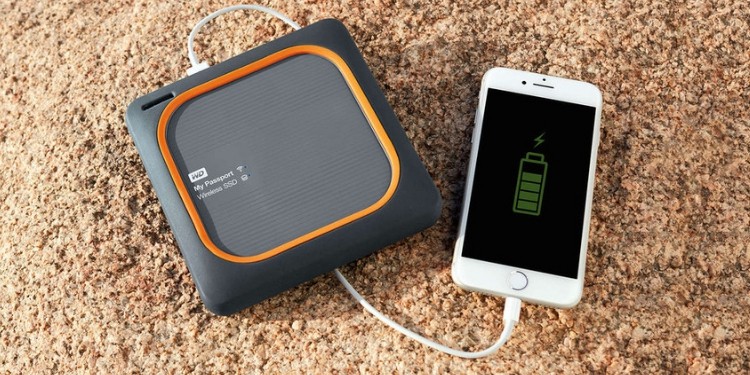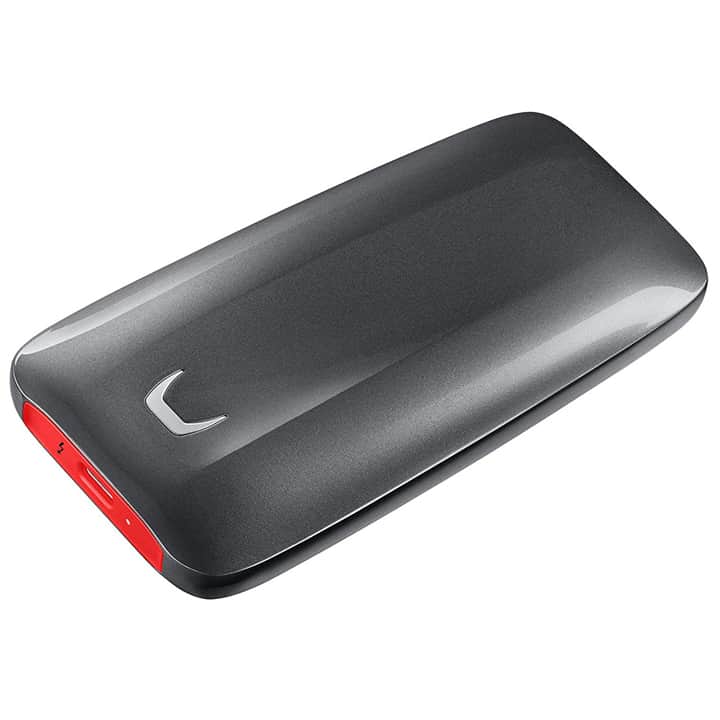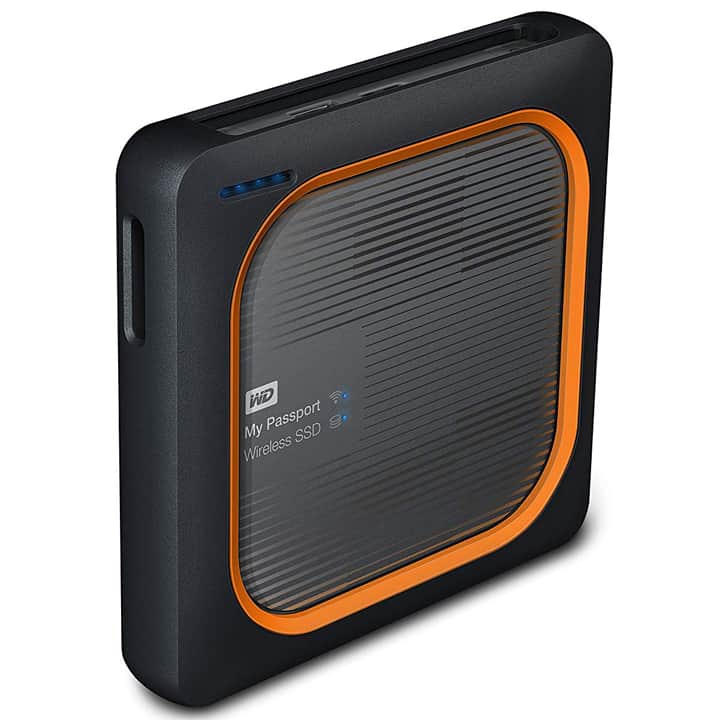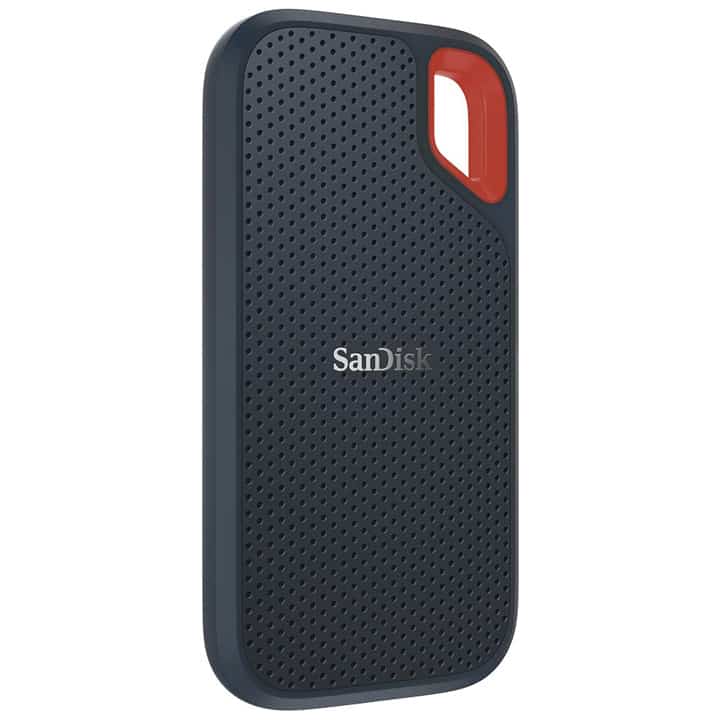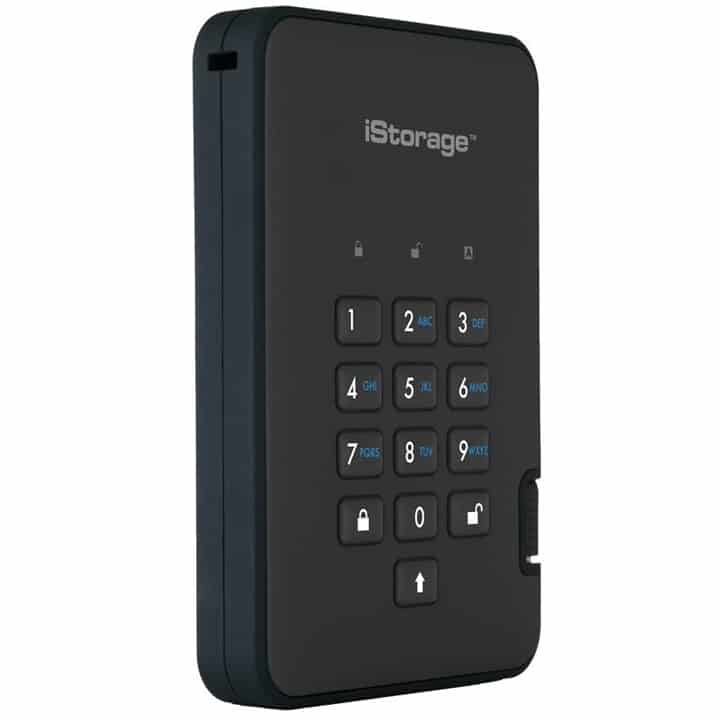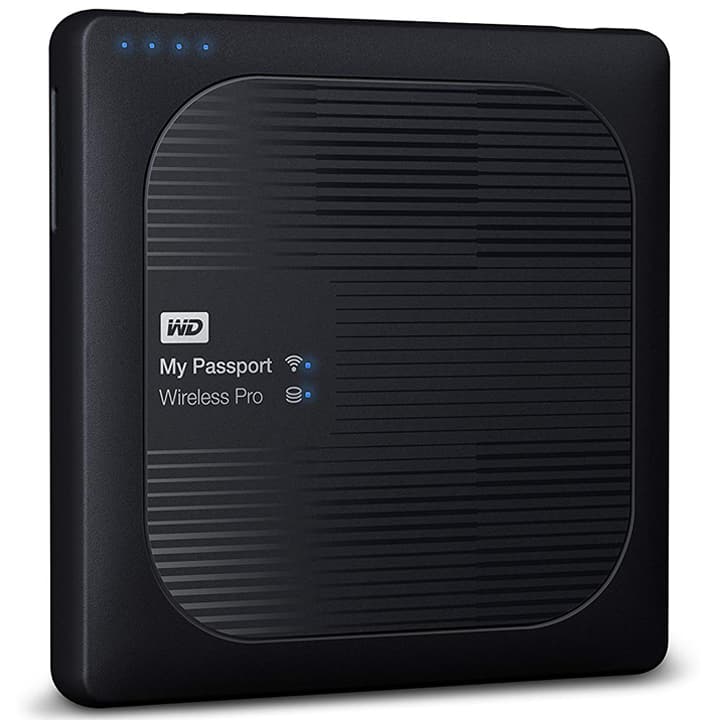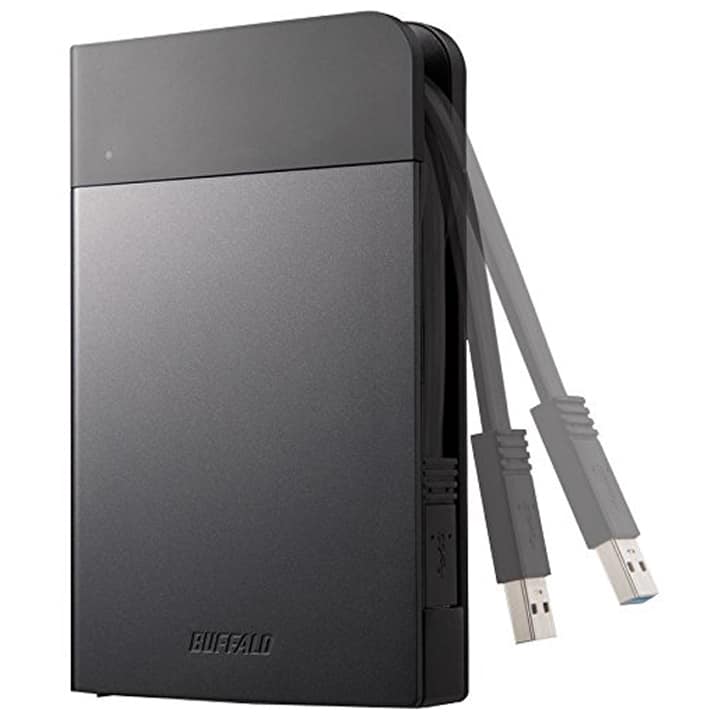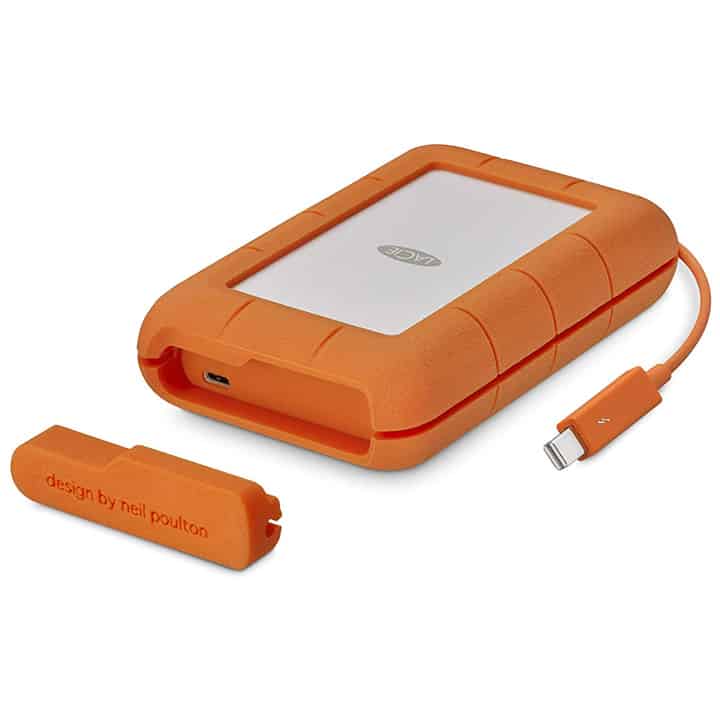The introduction of cloud computing might have reduced the need for an external hard drive, but, so long as you have data you need to store for a longtime or backup, they’ll never go obsolete.
Modern external hard drives are much better than their older variants, with better access times, faster transfer rates and, most of all, better reliability. Today, we will look into some of the best external drives ever released.
Fastest External Drive
Samsung X5 Portable SSD
- Type: SSD
- Read Rate: 2800 MBps
- Write Rate: 2300 MBps
- Connectivity: USB 3.1 Type-C with Thunderbolt 3 Protocol
Most Reliable
WD My Passport Wireless SSD
- Type: SSD
- Read Rate: 390 MBps
- Write Rate: N/A
- Connectivity: 802.11ac/n Wi-Fi, USB 2.0 Type-A, USB 3.0 Micro-B
Best for Tourists
SanDisk Extreme Portable External SSD
- Type: SSD
- Read Rate: 550 MBps
- Write Rate: 500 MBps
- Connectivity: USB 3.1 Gen-2 Type-C, USB 3.1 Type-A with the provided Converter
tamper-proof design
iStorage Diskashur2 HDD
- Type: HDD
- Read Rate: 148 MBps
- Write Rate: 140 MBps
- Connectivity: USB 3.1 Type-A
Most Feature-Rich
WD My Passport Wireless Pro Portable External Hard Drive
- Type: HDD
- Read Rate: 120 Mbps (estimate)
- Write Rate: 120 Mbps (estimate)
- Connectivity: 802.11ac/n Wi-Fi, USB 2.0 Type-A, USB 3.0 Micro-B
Cheap And Secure
Buffalo MiniStation Extreme NFC
- Type: HDD
- Read Rate: 86.8 MBps
- Write Rate: 74.2 MBps
- Connectivity: USB 3.0 Type-A
Large Capacity
LaCie Rugged TB USB-C Portable Hard Drive
- Type: HDD
- Read Rate: 130 MBps
- Write Rate: N/A
- Connectivity: Firewire 800 with Thunderbolt 2 protocol, USB 3.1 Type-C port
Table of Contents
1- Samsung X5 Portable SSD
The Fastest External Drive For PC
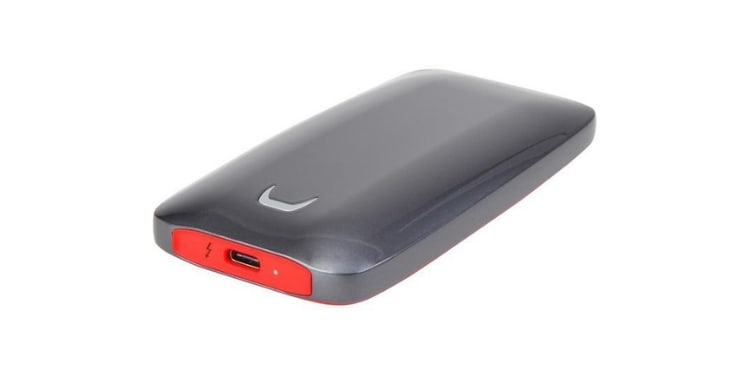
- Type: SSD
- Read Rate: 2800 MBps
- Write Rate: 2300 MBps
- Connectivity: USB 3.1 Type-C with Thunderbolt 3 Protocol
- The fastest read and write speeds
- Uses industry-leading NVMe protocol
- Extremely pricey
Samsung is currently the world’s leading company when it comes to SSDs with some of the fastest SSDs on the market; a similar case can be made for their external drives.
The Samsung X5 is an NVMe based SSD, with a USB 3.1 Type-C port, having support for Thunderbolt 3. All of this makes it one of the world’s fastest external drives, as NVMe protocol provides staggering I/O performance.
Speaking of speed, the Samsung X5 hosts a staggering read-rate of up to 2800 MBps while the write-rate is slightly lower at around 2300 MBps. There will not be a lot of practical uses for such high speed unless you intend to use the device professionally, with heavy data handling.
The drive is much smaller than most external drives (It is an SSD, so this is to be expected). The drive is packed in a high-quality case with glossy metal on top while the bottom side has a rubbery material for non-slippery placement.
Surprisingly, Samsung has used MLC V-NAND Flash in this SSD, which makes it twice as durable as most of the other SSDs, which use TLC NAND Flash most of the time. It is also fitted with a heat-sink inside the case, as these high-speed SSDs usually emit a lot of heat.
The only downside of this SSD is its tremendous price, which is why we recommend this external drive only if you have some serious data handling needs or a ton of extra money you want to burn.
2- WD My Passport Wireless SSD
The Most Reliable External Drive Ever Existed
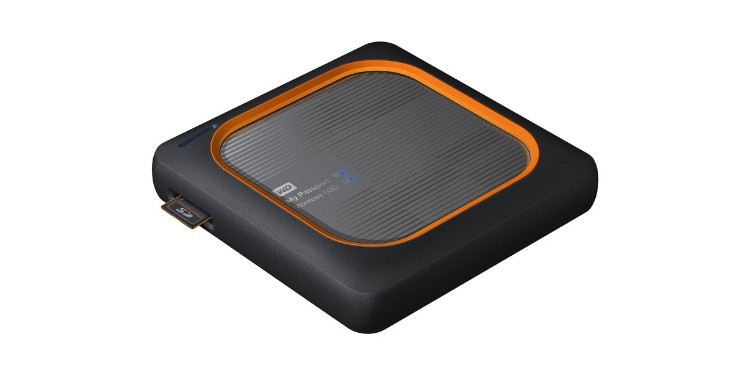
- Type: SSD
- Read Rate: 390 MBps
- Write Rate: N/A
- Connectivity: 802.11ac/n Wi-Fi, USB 2.0 Type-A, USB 3.0 Micro-B
- Wireless capability
- Comes with a built-in SD-card reader
- Could have provided a USB Type-C port
Western Digital is one of the most famous names when it comes to storage devices regardless of the type of storage device. The company is known mainly for manufacturing high-end mechanical drives but their SSDs are up to speed with the best the game.
The WD My Passport Wireless external drive is a heavenly storage device, fitted with tons of features.
The external drive provides wireless transfer along with wired connectivity and packs a 6700 mAh battery inside which can also serve as a power bank for your compatible devices such as phones, headphones, etc. The device also provides a built-in card reader inside and offers an option to automatically back-up the SD-card contents onto the drive.
The transfer rates of this drive are much slower than those of the Samsung X5, as this drive does not support the NVMe protocol nor has faster connectivity such as Thunderbolt 3. Moreover, the device does not support the USB 3.1 Type-C port, which would have been a great inclusion. Yet, the read/write rates of this drive are much faster than most of the external drives you will find on the market.
One minor nitpick is its physical design. Since it is a square with rounded corners instead of a rectangle, like most other external devices, it can be a bit more awkward to carry around. This is made more awkward by the fact that it’s meant to be portable.
At the end of the day, when it comes to features, this is definitely the best drive. As such, we recommend this external drive if you think you will take advantage of the extra features, like wireless support, power-bank, etc.
3- SanDisk Extreme Portable External SSD
The Best Portable External Drive for Tourists
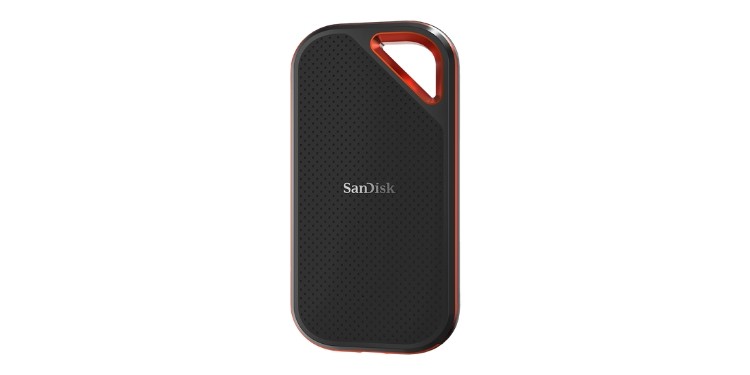
- Type: SSD
- Read Rate: 550 MBps
- Write Rate: 500 MBps
- Connectivity: USB 3.1 Gen-2 Type-C, USB 3.1 Type-A with the provided Converter
- Easy to carry/hang
- Water-proof design
- Runs fairly hot
The SanDisk Extreme Portable External SSD is a compact SSD-based external drive with a lot of attractive features. First of all, the shape of this drive is very pleasant-- it’s smaller than most modern smartphones-- and also offers a hole for hooking it to your backpack or purse (although we are not sure why you’d want to hang your over-$100 storage device with important data on it out in the public).
The case of the drive is ruggedized (that’s where you use it as a puck in a hockey game between bears and lumberjacks) and uses a rubbery material, which helps to protect it from drops; although, you should not worry about that very much, as these drives are much more reliable than mechanical drives when it comes to drops. This drive is also dust and water-resistant with an IP55 rating so you shouldn’t hesitate to use the drive in rainy weather.
Because of its compact, yet durable design, we really like it for the marketed use case: photography on nature expeditions.
The drive hosts a USB 3.1 Gen2 Type-C connector with a maximum bandwidth of 10 Gb/s. The read/write rates of this drive are limited at 550 MBps and 500 MBps respectively, which are as high as a high-end desktop SATA SSD. Due to such high-speeds and its compact design, the device does run quite hot, which is why you should use this in a well-ventilated area.
This drive might not be fitted with the wireless capability or SD-card slot like the WD Wireless SSD nor does it have the extreme speeds of the Samsung X5 but it is three times cheaper than those two drives which makes it a very attractive product.
4- iStorage Diskashur2 HDD
The Most Reliable External Hard Drive Pick
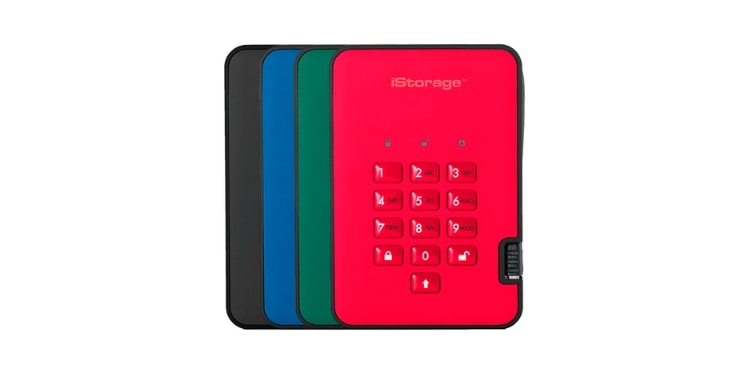
- Type: HDD
- Read Rate: 148 MBps
- Write Rate: 140 MBps
- Connectivity: USB 3.1 Type-A
- 256-bit AES encryption with Brute-Force Hack Defense
- Offers a tamper-proof design
- Pricey for being a mechanical hard drive
The iStorage Diskashur2 HDD is an external drive targeted towards customers who want to store highly important or confidential data. This drive is built like a tank and can withstand a lot of beating before the inner disk can be retrieved, as the disk inside is covered by a layer of super tough epoxy resin. There are number-keys on the top of the drive, which are used for locking/unlocking the drive while there is a USB 3.1 Type-A cable integrated into the drive.
The drive provides great security with real-time 256-bit AES-XTS encryption and is difficult to unlock with a brute-force attack. There is also a Self-Destruct feature, which safely erases all the data when you use the pin-code… sadly, this does not involve actually self destructing. Moreover, leaving the drive idle for a specified time results in lock-up, which is quite helpful in case you forget to lock the device.
For a mechanical drive, the performance is quite good with around 140 MBps sequential data transfer rate. The drive is a little pricey for an HDD though, which is why we recommend this external drive only to those who really need a strong and secure drive for their needs, as this is the most reliable external hard drive you will ever come across.
5- WD My Passport Wireless Pro Portable External Hard Drive
The Most Feature-Rich External Hard Drive
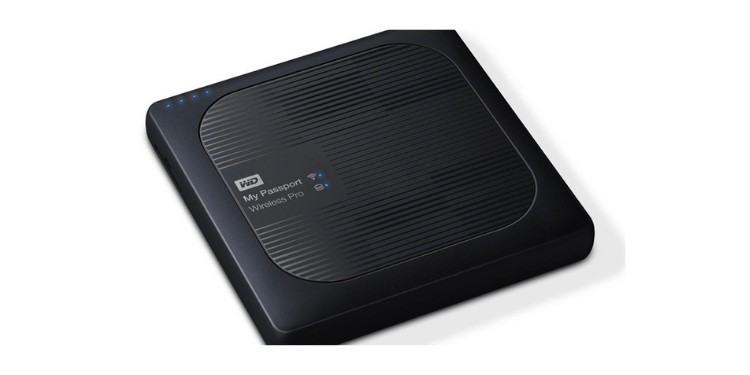
- Type: HDD
- Read Rate: 120 Mbps (estimate)
- Write Rate: 120 Mbps (estimate)
- Connectivity: 802.11ac/n Wi-Fi, USB 2.0 Type-A, USB 3.0 Micro-B
- Offers a built-in power bank
- Automatically imports the SD-card contents
- The Wireless Cloud App is not well-designed
The WD My Passport Wireless Pro is quite similar to WD’s My Passport Wireless SSD (yeah, the one we talked about above); it has similar connectivity and features. The main difference is that it costs a lot less since it has a mechanical hard drive inside, instead of an SSD.
With a built-in SD-card reader, the drive can copy the SD-card contents automatically without any proprietary or third party software. However, the drive needs to be updated to the latest firmware and configured properly in the settings (Software) to automatically start extracting data from your SD card.
That being said, the software application (Wireless Cloud App) feels incomplete and can be quite confusing at first. You will have to play around with it to get used to it.
Talking about transfer, the transfer rates of this drive are not listed officially, but due to the 5400-RPM it has, expect the drive to clock in at ~120 MBps (read and write); however, we were unable to confirm the exact speeds, so this should be taken with a grain of salt.
We believe that this external HDD is one of the best backup hard drives and is a great alternative to the WD My Passport SSD, as it provides similar features at a fraction of the price.
6- Buffalo MiniStation Extreme NFC
A Cheap And Secure Portable External Hard Drive
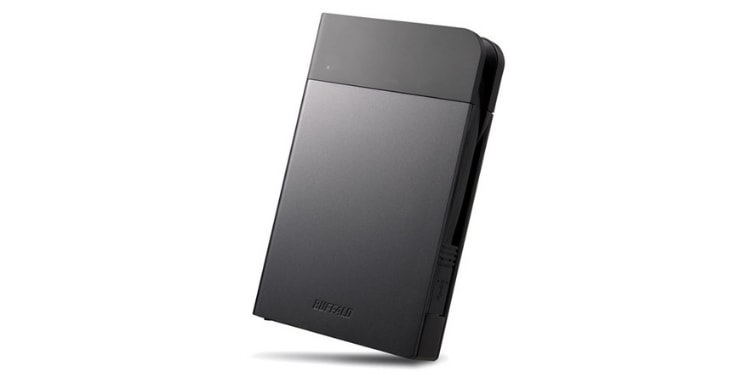
- Type: HDD
- Read Rate: 86.8 MBps
- Write Rate: 74.2 MBps
- Connectivity: USB 3.0 Type-A
- Offers NFC support for unlocking
- Comes with a 3-year warranty
- Poor user interface
The Buffalo MiniStation Extreme NFC is an elegant-looking external hard drive which features a US Military Standard rugged chassis. This external drive uses an integrated cable, offering USB 3.0 connectivity and provides NFC support, which can be used as an unlocking method for the drive. The drive also provides a smart card to wirelessly open it when it is configured to work in Secure mode.
The drive provides around 86.8 MBps read rate along with 74.2 MBps write rate, not bad honestly considering that this drive isn’t targeted towards speed but rather at longevity. The drive also provides AES hardware encryption, which makes it quite reliable in terms of security. The software of the drive lacks some finishing, as it crashes sometimes on some versions of Windows without showing any error which can be troublesome.
Nonetheless, this is one of the fastest external hard drives(mechanical), offering great reliability and security.
7- LaCie Rugged TB USB-C Portable Hard Drive
The Budget External Hard Drive With Large Capacity
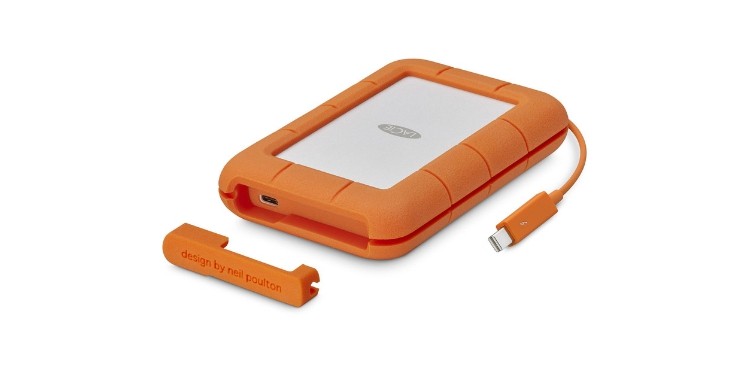
- Type: HDD
- Read Rate: 130 MBps
- Write Rate: N/A
- Connectivity: Firewire 800 with Thunderbolt 2 protocol, USB 3.1 Type-C port
- Available in capacity up to 5 TB
- Connection ports feel cheap
- The hard disk itself is not durable
The LaCie Rugged TB USB-C Portable Hard Drive, as the name suggests, provides USB 3.1 Type-C connectivity along with a Firewire 800 port with Thunderbolt 2 protocol. It is this connectivity that makes it attractive, as it is compatible with the latest Windows-based computers while supporting the older Apple products which featured Thunderbolt 2.
While the drive does feature a rugged design, we don’t recommend you carelessly toss it around (honestly, this holds true for most tech) as it contains physically moving components inside, which are not very durable. Moreover, if you buy this, make sure your cables are inserted all the way as this drive has pretty loose ports.
The read rate of the drive is limited to 130 MBps while having a similar write-rate. The device is also available in higher capacities up to 4 or 5 TBs, which makes it one of the best 4TB external hard drives.
Buyer’s Guide
External storage drives are a vital component that is often overlooked. Since you can have a fine computing experience without one, most don’t think about them… until something happens to their computer and they really wish they had a copy of all those thousands of photos. That being said, you don’t want to buy just any old hard drive, you’ll want the best external hard drive for your needs and means; that’s what this guide will help you figure out.
Storage Mechanism: Mechanical or SSD?
First of all, you’ll need to decide whether you should go for the cheaper, slower mechanical hard drives or the more expensive, but faster solid state drives (SSD). Mechanical hard drives use mechanical components to store data while SSD drives store the data electronically.
So, are SSDs worth their much higher price point? Well, it depends on how you are using your storage drive.
For instance, SSDs are more physically resistant, so if you’re using your external drive on the go, where it is more likely to get bumped and dropped, then an SSD is the way to go. If it’s just stored in your desk most of the time though, then an HDD may be a better fit.
When it comes to speed, it’s more nuanced. If you’re using the external drive to store programs you actively use, like games, then an SSD will make load times faster. However, if you’re not using programs and you are only dropping a couple hundred standard photos from your smartphone every month or two, then those massive read/write speeds will largely go to waste.
The more often you use your external drive and the larger those transfers are, the more useful an SSD will be. Otherwise, all that flash might just be for nothing.
Capacity
The capacity of an external storage drive is directly proportional to its price. If you are focusing only on storing some personal documents along with other small-size content, like family pictures, a 500-GB to 1-TB drive will fulfill your needs sufficiently. However, if you are intending to store other content, such as AAA games or Blu-Ray movies, then you should look for higher capacity drives.
An important thing to note here is that higher capacity HDDs have a higher failure rate, as they consist of more platters. However, SSDs are the opposite; the higher count of chips leads to a better life.
Transfer Rates
For the most part, transfer rates sit along a couple of important technological fault lines:
- HDDs. Most of mechanical hard drives usually have transfer rates around 100-150 MBps because of limitation of their mechanism
- SATA SSDs. These can be all over the place, but they are usually between 300 and 600 MBps
- NVMe SSDs. The latest NVMe drives have transfer rates up to several GBs per second
Extra Features (Protection, Connectivity and Warranty)
- Physical Protection. Many of the external drives now come with shock-proof designs and some of them are also dust and water-proof. This feature is certainly useful for people who want travel a lot. Some even receive IPX waterproof ratings, like the SanDisk Extreme.
- Connectivity. The ThunderBolt 3 can be helpful for people who work with Apple devices while the USB 3.1 Type-C port is getting more popular.
- Warranty. Some manufacturers offer a 1-year warranty for their external drives while others provide as high as a 3-year warranty along with data recovery features. Therefore, if you want to go for a reliable drive, make sure to get the one which offers a longer warranty.

